Search Results for 'William Joyce'
15 results found.
‘You wouldn’t happen to be William Joyce, would you?’
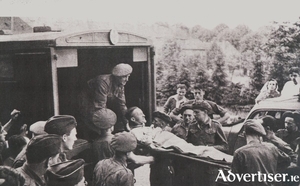
William Joyce was born in Herkimer Street, Brooklyn, New York in 1906 to Gertrude (who was originally from Lancashire) and Michael Joyce, a native of Killour, Co Mayo. Michael had taken American citizenship, which automatically made his family citizens. In 1909, the family returned to Ireland, initially to Mayo, then to Galway.
From trams to buses

When the Galway-Salthill Tramway ceased trading in 1918, it caused a problem for locals who had been using the service as public transport so a group of local businessmen came together on April 5, 1919 to register The Galway General Omnibus Company Limited as a public company. The directors were Thomas McDonough, Joe Young, Robert Mackie, Michael Crowley, Philip O’Gorman, Martin Hynes and Martin Finan. John Leech was the secretary and Joseph Garvey the manager.
A lone figure at Bohermore cemetery
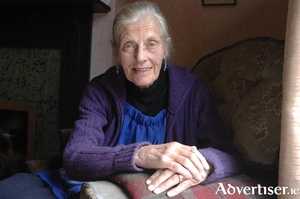
William Joyce recorded his final broadcast on April 30 1945 as the last great battle of the war raged. Russian troops, after a desperate struggle, finally wrenched Berlin from the grip of the Nazis. The once great city was then little more than streets of rubble. In an iconic World War II photograph Soviet troops fly the Soviet flag over the Reichstag May 2 1945.
‘Irish dockworkers fought elbow to elbow with old Jewish men in Hasidic hats...’
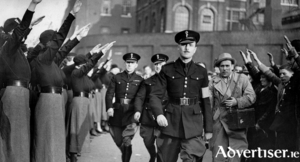
William Joyce’s notorious broadcasts to Britain, which continued throughout the six years of World War II, initially came from the studios in Berlin, later transferred to Luxembourg city, due to heavy Allied bombing, and finally from Apen, near Hamburg. The broadcasts were relayed over a wide network of German controlled radio stations in Zeesen, Hamburg, Bremen, Luxembourg, Hilversum, Calais, and Oslo. It had a huge potential audience, and was seen as a vital propaganda tool for Nazi Germany.
The boy from the Jes, who became the voice of Germany
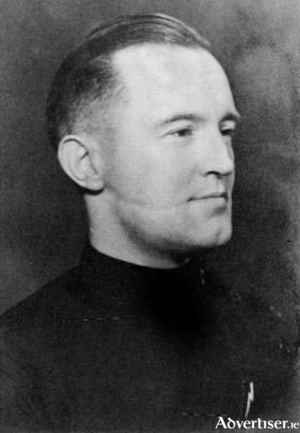
The late Billy Naughton, College Road, said he spluttered into his cup of tea, when he instantly recognised the upper-class, nasal drawl, of William Joyce reporting continuous Nazi victories on Radio Hamburg, Reichsrundfunk, during its English-language broadcast in October 1939. He was ridiculed as ‘Lord Haw-Haw’ and was the butt of Musical Hall jokes, yet he was listened to and despised for his clever mix of fact and lies.
The end of the line
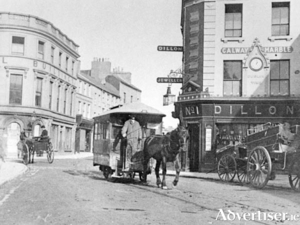
Fifteen years before the Galway-Clifden railway started, the first light-rail track laid in Galway was the tram service to Salthill. For more than 39 years a series of horse-drawn trams ran from the depot in Forster Street, along the east and south sides of Eyre Square, heading west through Shop Street and Dominick Street, over the bridge, and along the Salthill road. Then it was in the countryside with open fields and thatched cottages. The line came to an end at the Eglinton Hotel (now a hostel), where the horse was switched to the other end of the tram for the return journey. The Eglinton became Europe’s most westerly tram terminus.
Father Michael Griffin

Michael Joseph Griffin was born on September 18, 1892, in Gurteen in east Galway, one of five children of Thomas Griffin and Mary Kyne. He was educated locally, then in St Joseph’s College, Ballinasloe, and finally in Maynooth. He was ordained in April 1917 and was seconded to the Galway diocese. He worked for a year in Ennistymon and in June 1918 was transferred to the parish of Rahoon which stretched from the river out to Furbo and Corcullen. He developed a great rapport with the children of the parish, spoke in Irish to young and old, organised feiseanna, currach races, and donkey races on Silver Strand.
Poems for the Lockdown - Bohermore cemetery
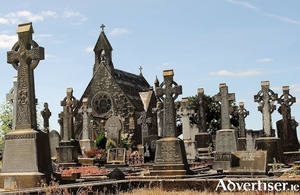
I WROTE this poem in 2014 after the English poet Helen Mort, who, as well as being an excellent poet, is an accomplished cross country runner, asked me: "And do you run?"
One hundred and fifty years racing at Ballybrit

We know that horse races were organised in different parts of County Galway from the middle of the 18th century, in places like Kilconnell, Eyrecourt, Rahasane, Ballinasloe, Ballymoe, Carraroe, and Bermingham House near Tuam. They were known as ‘racing matches’. In 1764, there was a five day meeting held at Knockbarron near Loughrea, and between 1829 and 1857, 15 meetings were held in Kiltulla near Ballybrit. In 1867, a series of races was organised at Bushfield near Oranmore.


